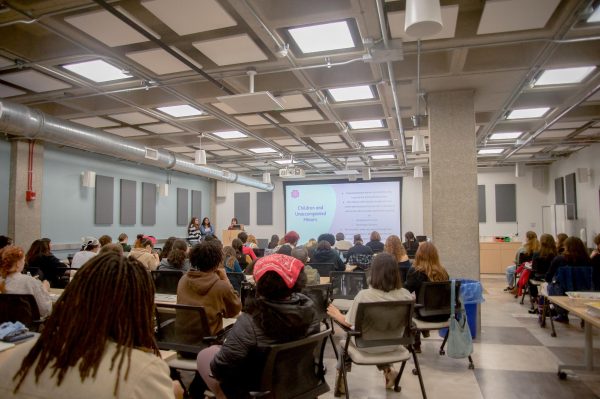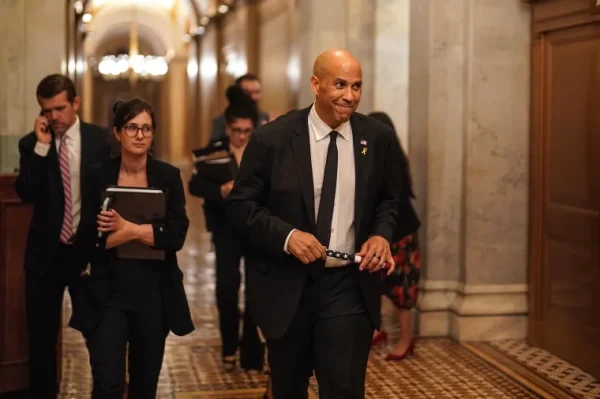Trustees Stalling With New Faculty Compensation Review
On March 10, over 200 students marched from Tappan Square to the Cox Administration Building, delivering rousing speeches and standing in solidarity with faculty in calling for better treatment and compensation for College employees. Last week, at the encouragement of Oberlin’s chapter of the American Association of University Professors, some faculty members canceled classes in protest. These recent events are symptoms of growing exasperation with the College’s inaction and apathy on the issue of faculty and staff compensation — a trend that’s been around for almost a decade.
“Faculty salaries have been stagnant for some years,” wrote Chair of Rhetoric and Composition Laurie McMillin in an email to the Review. “If you compare Oberlin to similar institutions, we used to be in the middle [of faculty pay rates] and now we’re at the bottom.”
Board of Trustees members, President Carmen Twillie Ambar, and members of the College’s administration have all spoken out at various intervals about the conversations happening on campus. Every comment issued has used similar rhetoric and been dismissive of the faculty’s demands. The trustees’ March 1 letter and President Ambar’s statement following the protest both concede to some extent that faculty deserve improved pay, but neither indicates that they are considering bringing that to fruition.
“[Faculty compensation] is the most important financial commitment the institution makes, it’s the largest; it is also a commitment that you make for the long term,” Board of Trustees Chair Chris Canavan, OC ’84, said in a statement to the Review. “We also know that for faculty, compensation is the source of financial stability for them and for their families. And so we need to be sure that when we make a commitment like that, it is stable, resilient, and sustainable.” Yet, when faculty have submitted motions to the board, they are met with the response that other priorities are of higher importance.
The One Oberlin Report indicates that approximately 60 percent of the College’s operating budget goes toward compensation across employee groups, and that this number needs to decrease for the financial stability of the institution. Why? We have the funds to plan renovations in dormitories and in the basement of Mudd Center, create entirely new administrative positions in Student Life, and pour money into the Sustainable Infrastructure Project — all in service of the argument that these investments bring Oberlin up to date with prevalent practices in higher education and are critical to the long-term success of the College. What is overlooked here is that prospective students may love the idea of air-conditioned dorms and newly renovated spaces to learn collaboratively in Mudd, but they will be disenchanted by the declining quality of the faculty and the growing evidence of faculty frustration. The board and administration must recognize that an exceptional and dedicated faculty is also a critical long-term investment. The quality of education is what determines the success of an institution, not the material comforts it affords along the way.
One impassioned argument pushes for faculty compensation to be pulled directly from the endowment. Indeed, it seems to follow that if there’s a pot of money for the College’s use, it should be spent on sustaining teaching at a primarily teaching institution. Two separate faculty motions have recommended pulling from the endowment — most recently, Professor of Mathematics Jeff Witmer calculated that a mere 0.3 percent increase in the endowment payout rate on top of the 4.4 percent allocated for this year toward compensation would result in an additional $3 million going to faculty every year.
There are some truths we acknowledge here. First, tying faculty salaries to the endowment, which would allow the College to draw more in more profitable years, would mean that minor fluctuations in the endowment would directly translate to fluctuations in that payout rate and in faculty salaries. It is also true that most institutions limit their annual payout rate to an average of 4.3 percent, whereas in a normal year, the College will draw roughly 4.5 percent from its endowment. Given that the College’s financial structure is currently dependent on an average yearly withdrawal capped under 5 percent, asking to withdraw money to increase faculty compensation would either mean an increase in the percent we take from the endowment every year — thereby threatening the institution’s financial viability — or take funds away from projects that are already prioritized in receiving endowment money. With that said, the fact is that the endowment exists to support the long-term sustainability and success of the College, both of which are inextricably tied to the quality and contentment of our faculty. If the business practices of the College encourage no more than a specific, small amount of money be taken from the endowment, then it stands to reason that the majority of that should go towards compensation.
Taking all this into account, the question still remains: Where should the money for increased faculty compensation come from? Even assuming the endowment is off-limits — barring another comprehensive readjustment of how the College approaches its finances — there are other resources to bolster faculty compensation. The College earns money primarily from two sources: tuition and donations. Annual full tuition costs, which account for the bulk of the College’s operating budget, have increased by $3,408 per student since the academic year 2019–20, and will no doubt continue a steady climb. But further raising tuition to meet faculty needs seems like a dangerous path to take.
One possible solution: the College conducts massive outreach programs to alumni for all kinds of projects, and if we truly are in such dire straits with the money already available to us, it might be time to ask for donations for faculty positions. Given the growing number of alumni who are speaking out in support of the faculty in their struggle for fair compensation, it seems reasonable to assume that they would be willing to give financial support to the cause as well. By directly endowing a faculty position, alumni can make sure their money is used where it is most needed, and simultaneously tie the administration’s hands.
The Board’s March 1 response to a recent faculty motion includes a call for President Ambar to conduct a long-term compensation review. “We need to know what compensation looks like at peer institutions: how it helps them attract and retain exceptional scholars and educators, pay equitably, and increase diversity,” reads the Board’s letter. Yet, according to One Oberlin, Arts & Sciences faculty are paid “significantly below the average of relevant liberal arts market peers, sometimes known as the Sweet 16.” If the College’s own report outlines this fact so simply, presumably based on its own collected data, why do they need to conduct a new survey? The last official compensation review — other than the aforementioned comparison in the One Oberlin report — occurred in 2013 and resulted in the notoriously unmet compensation goals. Instead of agreeing to go back to the initial 2013 commitment, the College is yet again calling for a compensation review. Given the lack of follow-through on the past two, the announcement of a new review does not bode well.
This Editorial Board is yet again joining the chorus of voices speaking out against the College’s ambivalent approach to faculty compensation. We ask for transparency regarding the intentions behind the upcoming compensation review, in light of the College’s failure to follow through on promises made after previous reviews. We ask that, instead of kicking the can down the road and hoping for minimal upheaval, the Board and administration prioritize the development of creative solutions to the problem of faculty compensation. Our faculty are our greatest asset, the bedrock of our community. It’s time to start treating them accordingly.



